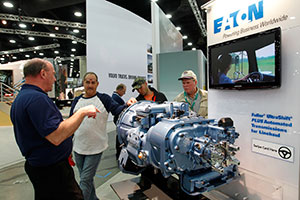Fleets Boost Use of Automatic Transmissions in Bid to Recruit Skilled Drivers, Study Finds

This story appears in the June 16 print edition of Transport Topics. Click here to subscribe today.
Fleets are expanding their adoption of semi- and fully automatic transmissions and using natural gas to power a small but growing percentage of their trucks, according to a recent study by Frost & Sullivan.
On average, fleet managers said that 47% of their trucks will be equipped with automated manual and fully automatic transmissions in 2015, up from 38% this year, the annual study found.
Sandeep Kar, global director of automotive and transportation research at Frost & Sullivan, said the industry’s “severe shortage of skilled drivers” is driving the growth.
“It is a fact that manual transmissions deliver higher fuel efficiency but only when operated correctly,” he said. “It’s easier for a fleet manager to put an unskilled driver in a truck with an automatic or semi-automatic transmission.”
The results were based on a survey of 101 fleet managers at for-hire and private U.S. fleets operating Classes 6-8 trucks. It was conducted in March and April.
Respondents also said 33% of their trucks are outfitted with 12- or 13-liter diesel engines with selective catalytic reduction aftertreatment but expect that figure to rise to 37% next year.
They also said the percentage of their fleets using 15-liter diesel engines with SCR will rise to 24% next year from 22%.
Manufacturers added SCR technology to their engines to meet the Environmental Protection Agency’s 2010 emissions standards.
Only a small portion of the fleet managers who were surveyed said they are using alternative fuels, but that number is expected to increase for natural-gas systems.
Fleet managers said they expected an average of 3.8% of their trucks to run on compressed natural gas next year, up from 2.5% this year, while liquefied natural gas was expected to increase to 2% from 1.1%.
Diesel-electric hybrids, however, were expected to fall to 2% from 4.3% this year.
Kar said he suspects that the fleet managers who are interested in alternative fuel systems are shifting their attention toward natural gas and away from hybrids.
He said the growing adoption of CNG and LNG is being spurred by the lower cost of natural gas compared with diesel, as well as the availability of a
12-liter natural gas engine with last year’s launch of the Cummins Westport ISX12 G.
Another factor supporting the growth is the improved availability of fueling infrastructure for regional fleets, Kar added.
Frost & Sullivan forecasts that 8% of the Classes 6-8 trucks sold in 2018 will be powered by natural gas, he said.
The survey found that 41% of fleet managers responding would consider moving to CNG or LNG engines for savings of
$1 per diesel gallon; 11% said they would consider the investment at $1.50 per gallon in savings; 28% would do so at more than $1.50 savings and 21% said they wouldn’t consider the alternative fuel at any price.

